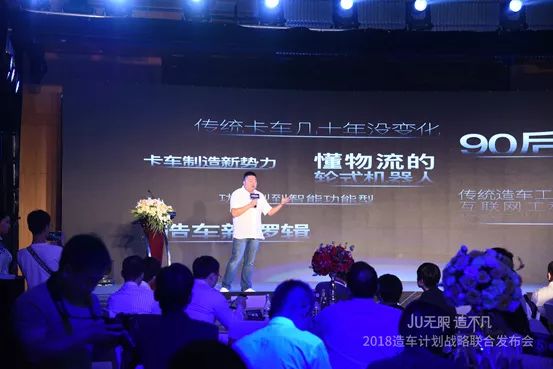Title: The Four-party Cooperation in the 2018 Intelligent Truck Plan
I have to admit that the headline of this article is somewhat misleading. Although WM Motor and JD Logistics did play crucial roles in the collaboration, it was actually a four-party cooperation, and the significance of the relatively lesser-known companies Prologis and Juma is not inferior to the former two in the B2C field.
To facilitate understanding, it is necessary to briefly introduce the background of Prologis and Juma:
- Prologis: the provider and service provider of China’s largest modern industrial park. Prologis and its brand Huanpu invest, develop, and manage 267 logistics parks, industrial parks, and sci-tech parks in 38 strategic regional markets, with a total property area of 33.4 million square meters.
- Juma: an urban delivery service provider. It has established 137 subsidiaries in 61 cities such as Chengdu, Chongqing, Shenzhen, Guangzhou, Shanghai, and Xi’an, providing delivery services for hundreds of companies such as SF Express, Tmall, and Haier.
(Quoted from official website)
Together with WM Motor, a leading Chinese new car maker, and JD Logistics, a leading logistics company, the four parties jointly announced the “2018 Truck Manufacturing Plan” and jointly funded the establishment of an intelligent truck company.
What is an intelligent truck? In fact, it is “Internet plus truck”. Although the term “Internet plus” has been overused in the past two years, this cooperation is indeed such a thing. Bai Rubing, founder and CEO of Juma Group, mentioned an interesting detail at the press conference. He said that it is already 2018, but many trucks still do not have electric windows.
What does that mean? Today’s main manufacturers of trucks define their products too far from users and needs. They make products based on long-standing basic requirements such as load capacity, emission standards, and endurance. This has first led to a decrease in the user experience of the driver and more importantly, a decrease in the operational efficiency of the entire logistics industry.
So what changes can the Internet bring to trucks or the logistics industry?
Let’s take a look at several key words on the PPT during the press conference: forward-looking R&D, scenario-based research, upstream and downstream linkage capabilities, digitalization, and intelligent empowerment.
Forward-looking R&D ensures that from the beginning of product definition, the needs of the driver and the logistics owner are taken into full consideration to improve user experience and owner satisfaction. Scenario-based research and upstream and downstream linkage are inseparable. For example, upstream WM Motor, middle-stream Prologis, downstream Juma, and JD Logistics cooperated to provide demand around truck operation scenarios, making the final product more closely aligned with actual scenarios. Digitalization and intelligent empowerment are even more multi-faceted. For example, launching Didi of the logistics industry and better matching supply and demand through big data scheduling, greatly improving the driving safety of trucks through a cost-controllable intelligent assisted driving system, and even more long-term, realizing fully unmanned automatic driving truck fleet dispatch.One the one hand, by detecting the driver’s state and behavior, it greatly reduces the possibility of fatigue driving and drunk driving, avoiding potential personal accidents and financial losses.
On the other hand, many submarkets in the logistics industry, such as fresh produce, pharmaceuticals, hazardous materials, have extremely high requirements for timeliness, which poses a huge challenge to logistics companies’ scheduling capabilities. This is a very typical market that is suitable for overall scheduling through big data platforms to improve operational efficiency. Using machine algorithms combined with sensor data to schedule capacity will undoubtedly better alleviate the generally existing supply-demand imbalance problem.
Looking at today’s several industrial partners, ProLogium is first and foremost a logistics infrastructure operator. At the same time, its capital and industrial incubation capabilities will help to better promote this truck to the market. JD Logistics has rich experience in efficient scheduling, and also has a huge demand for smarter trucks. WM Motor has deep technical accumulations and supply chain bases in the R&D of electric motor, electric control, and battery technologies for new energy vehicles. The truck’s power assembly “from oil to electricity” will bring significant improvements in both driving experience and energy consumption.
The goal of Juma is to use smart terminals to connect drivers with the business through OPEN API, providing logistics maps, multi-point collection and distribution, remote real-time diagnostics, and intelligent hazard reminders. It supports various complex logistics scenarios, and behind each truck there is a set of logistics SAAS platforms and asset management platforms to escort and protect.
Simply put, this truck will simultaneously connect users, scenarios, management, and car services through the system. Juma’s goal is to start mass production and launch it in the market in 2020.
This four-party cooperation is actually worth pondering, especially for Internet people. Lin Yuanqing, the former director of Baidu Research Institute, said that there are huge opportunities for AI in every traditional industry. You don’t have to focus on the white-hot competition in new retail, shared travel, and autonomous driving. Any traditional industry + Internet has the potential for transformation and upgrading.
Juma’s transformation of the logistics industry is a clear proof.

 * NETA N01 is Offline, What is Hezhong New Energy Planning?
* NETA N01 is Offline, What is Hezhong New Energy Planning?

This article is a translation by ChatGPT of a Chinese report from 42HOW. If you have any questions about it, please email bd@42how.com.
